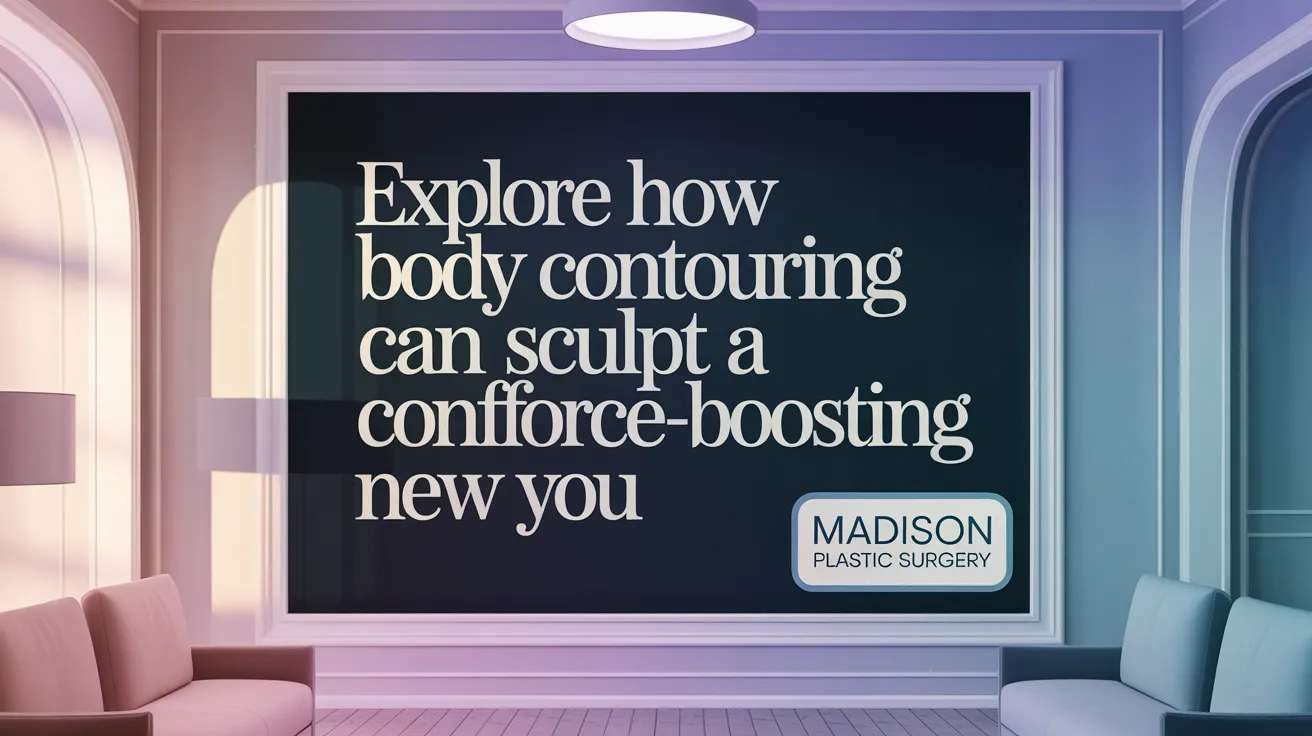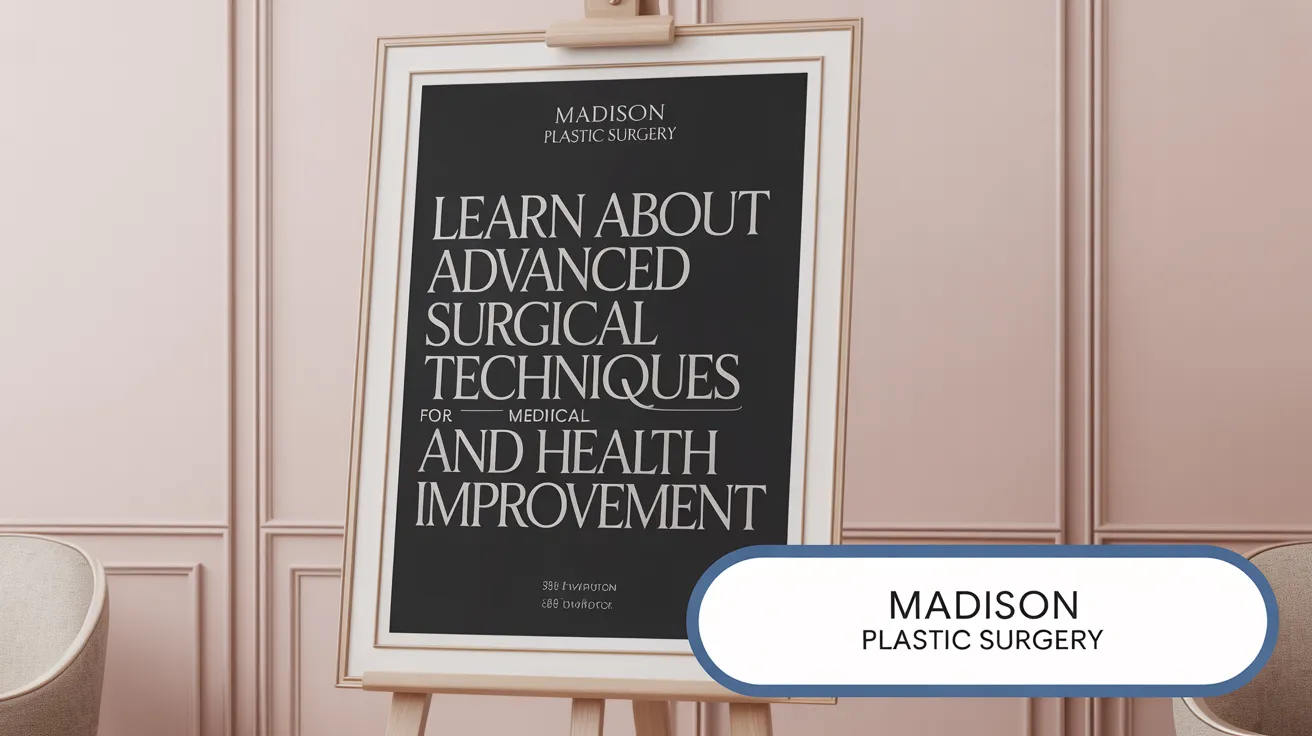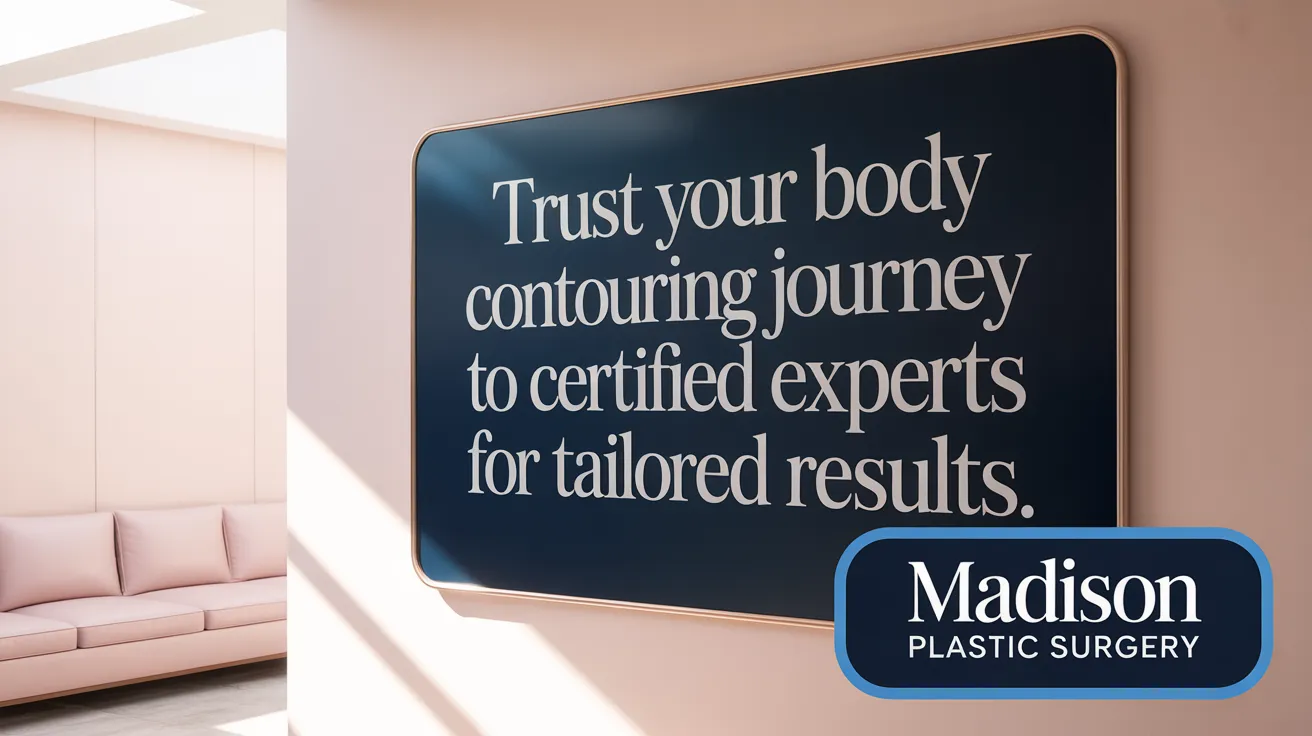Introduction to Body Contouring and Sculpting
Defining Body Contouring and Its Purpose
Body contouring, also known as body sculpting, is a refined practice aimed at reshaping specific areas by removing excess fat and skin to enhance body proportions and restore confidence. It is particularly valuable for individuals seeking improvement after significant weight loss or for those frustrated by stubborn fat resistant to diet and exercise.
Surgical vs. Non-Surgical Approaches
This craft encompasses both surgical options like liposuction, lifts, and tucks—which provide immediate and often dramatic results—and minimally invasive or non-surgical methods such as cryolipolysis (CoolSculpting®), laser lipolysis, and radiofrequency treatments that offer gradual improvements with minimal downtime. Each modality is chosen carefully to align with patient goals, medical history, and desired recovery time.
Emphasizing Natural Beauty Through Safety
In advanced aesthetic treatments, achieving a natural look is paramount. By leveraging mastery in surgical techniques and innovative technologies, practitioners ensure enhancements are subtle, balanced, and harmonious with the patient's inherent features, prioritizing safety and patient-specific customization.
Ideal Candidates for Advanced Body Sculpting
Body contouring is best suited for healthy individuals with stable weight who desire targeted refinements rather than weight loss. Patients seeking personalized, precise enhancements that restore natural, youthful contours and elevate self-esteem often find these treatments transformational.
Understanding Body Contouring: Techniques and Benefits

What Are the Techniques Used in Body Contouring?
Body contouring encompasses both surgical body contouring options and nonsurgical body contouring methods designed to reshape targeted body areas by removing excess fat and skin or tightening tissue. Surgical procedures include liposuction procedure, tummy tuck surgery, and lifts such as arm or thigh lifts, often performed under anesthesia and requiring recovery time ranging from weeks to months.
Nonsurgical options focus on fat reduction and skin tightening through minimally invasive technologies. These include cryolipolysis (CoolSculpting®), which freezes fat cells; injection lipolysis using agents like deoxycholic acid; laser fat reduction (SculpSure®); radiofrequency treatments such as truSculpt® and Thermage; and ultrasound technologies that stimulate collagen production and fat breakdown. These treatments typically involve little to no downtime and multiple sessions may be needed for optimal results.
Which Areas are Commonly Treated?
Body contouring targets several common areas where stubborn fat or loose skin often persist despite diet and exercise efforts. These include:
- Abdomen and love handles
- Arms and back
- Thighs and buttocks
- Neck and chin
Addressing these zones helps patients achieve a more harmonious and youthful body contour. For more information about common body contouring target areas, see this resource.
What Are the Benefits of Body Contouring?
Beyond visible fat reduction and removal of excess skin, body contouring offers several notable advantages:
- Enhanced body shape with improved muscle tone and definition (Benefits of body contouring, Body sculpting benefits)
- Smoother, tighter skin due to collagen stimulation and skin tightening effects (Skin tightening procedures, Collagen and elastin stimulation)
- Rejuvenation that restores confidence and overall well-being (Boosting self-confidence with body contouring
- Quick treatment times with minimal interruption to daily life, especially in nonsurgical options (Minimally invasive cosmetic procedures)
How Long Do Results Last and What Should Patients Do to Maintain Them?
Results from body contouring procedures are generally long-lasting as fat cells are permanently removed or destroyed. However, maintaining a healthy lifestyle with balanced nutrition and regular exercise is vital to preserve those outcomes and prevent new fat accumulation. Many practitioners recommend post-procedure compression garments and follow-up care to optimize healing and final appearance.
In summary, a personalized approach combining surgical and nonsurgical techniques can create natural-looking, durable improvements in body shape and skin quality, helping individuals feel comfortable and confident in their appearance.
Exploring Non-Surgical Body Sculpting Options

What are the common nonsurgical fat reduction methods?
Nonsurgical body sculpting employs targeted technologies to reduce stubborn fat pockets without the need for incisions or anesthesia. Popular methods include:
-
Cryolipolysis (CoolSculpting): This FDA-cleared procedure uses controlled cooling to freeze and eliminate fat cells, effective on areas like the abdomen, flanks, thighs, back, and under the chin. Each session lasts about 35 to 60 minutes, with fat reduction of up to 25% per treatment. Learn more about the cryolipolysis mechanism.
-
Laser Fat Reduction (SculpSure): Utilizing controlled laser heat, this technique dismantles fat cells primarily on the abdomen and flanks. Results develop over 6 to 12 weeks post-treatment.
-
Injection Lipolysis (Kybella): Approved for submental fat (double chin), Kybella involves multiple injections of deoxycholic acid to destroy fat cells permanently.
Other emerging approaches include red light therapy and ultrasound-based treatments, expanding options for patient-specific needs.
What are the advantages of nonsurgical methods?
Nonsurgical body contouring offers several benefits, as detailed in this comprehensive body contouring overview:
-
Minimal Downtime: Patients usually resume normal activities immediately after treatment, contrasting with longer recovery times seen in surgical alternatives.
-
Gradual, Natural-Looking Results: Fat cell elimination progresses subtly over weeks or months, allowing for a natural enhancement in body shape.
-
Safety and Comfort: Without anesthesia or incisions, side effects are generally mild, such as temporary redness or soreness.
-
Convenience: Most sessions are short, typically less than an hour, easily fitting into busy schedules.
What are typical treatment durations and recovery processes?
Treatment sessions vary from 30 to 60 minutes depending on the method and targeted area. Multiple sessions may be necessary to achieve desired results, spaced weeks apart to allow the body to metabolize destroyed fat cells. Recovery is usually immediate with minimal post-procedure restrictions. For details on the post-procedure recovery, see comprehensive guides on recovery and care.
Who is suitable for nonsurgical contouring?
Ideal candidates have a body mass index (BMI) under 30 and have achieved a stable weight but wish to reduce localized fat deposits resistant to diet and exercise, as outlined in nonsurgical body sculpting suitability. Common treatment areas include the abdomen, thighs, love handles, back, upper arms, chin, and neck.
These techniques are not weight loss solutions but are designed to refine and sculpt targeted regions, complementing a healthy lifestyle.
Selecting a board-certified plastic surgeon or qualified specialist ensures safe, effective treatment tailored to individual anatomy and goals.
Surgical Body Contouring: Procedures and Considerations

Common Surgical Procedures
Surgical body contouring seeks to reshape the body by removing excess fat and skin, providing immediate and more dramatic results than nonsurgical alternatives. Popular procedures include:
- Liposuction procedure: Uses a suction device called a cannula to precisely remove fat deposits. Power-assisted liposuction allows targeted contouring.
- Tummy Tuck (Abdominoplasty): Removes excess skin and tightens underlying muscles, especially effective post-pregnancy or significant weight loss.
- Breast Lift (Mastopexy): Elevates and reshapes sagging breast tissue for a youthful profile.
- Facelift: Tightens facial skin and underlying muscles to reduce sagging and rejuvenate contours.
Steps Involved in Surgical Procedures
The surgical process begins with a thorough pre-operative consultation, where the plastic surgeon reviews medical history, discusses aesthetic goals, photographs and measures target areas, and explains risks. Pre-op preparations may include blood tests and medication adjustments.
On the procedure day, the patient undergoes anesthesia administration, followed by surgical site marking. Incisions are made to remove or reposition fat and skin; muscle tightening may occur in procedures like a tummy tuck. The surgeon then closes incisions carefully to minimize scarring.
Post-operative care involves wound management, monitoring for complications, and activity restrictions. Recovery typically takes several weeks to months, requiring support for transportation and daily tasks initially.
Immediate and Noticeable Effects
Surgical contouring provides more immediate reshaping and definition compared to gradual nonsurgical methods. Patients experience a visible improvement in body shape with smoother skin and rejuvenated contours soon after surgery. For more on these benefits, see Benefits of Body Contouring.
Risks and Safety Measures
As with any surgery, risks include bleeding, infection, scarring, anesthesia complications, nerve or tissue damage, and asymmetry. To mitigate these, selecting a board-certified plastic surgeon with extensive experience is critical. Pre-operative health optimization, adherence to surgical guidelines, and vigilant post-op monitoring reduce risks and enhance safety. Learn more about Risks of Surgical Body Contouring.
Patients should be informed about signs of complications to watch for after body contouring like excessive bleeding, fever, or severe pain and seek prompt medical attention if these occur.
Advanced Technologies Enhancing Body Sculpting Outcomes
What advanced technologies are used for skin tightening and body sculpting?
Innovative minimally invasive devices such as Renuvion skin tightening technology combine heated helium gas with radiofrequency energy to achieve impressive skin tightening results. This technology allows for contraction and rejuvenation of tissue with precision and minimal downtime, ideal for patients seeking refined contours without extensive surgery.
Ultrasound cavitation treatment represents another cutting-edge approach. It uses advanced ultrasound waves to disrupt fat cells and stimulate collagen production, assisting in reducing stubborn fat, smoothing cellulite, and improving skin texture. This method is non-invasive and promotes natural detoxification, contributing to a revitalized appearance.
Radiofrequency skin tightening treatments employ targeted energy to stimulate collagen and elastin, essential proteins for firm, youthful skin. These procedures are safe, clinically validated, and approved by health authorities such as the TGA and FDA. They enhance skin tone and elasticity, often delivering gradual yet consistent improvements over several weeks.
How do combined treatments improve outcomes?
Combining ultrasound cavitation with radiofrequency therapy maximizes benefits by addressing multiple concerns simultaneously. This synergy enables effective fat reduction, improved skin firmness, and visibly diminished cellulite. Patients often notice smoother, tighter skin and a more contoured silhouette after a course of combined treatments.
Additionally, these advanced modalities offer the convenience of minimal discomfort and no downtime, permitting a quick return to daily activities. Safety is rigorously maintained through regulatory clearances and expert supervision, ensuring patient confidence and comfort throughout the treatment journey.
These modern technologies represent a significant advancement in body sculpting techniques, catering to individuals desiring natural-looking, elegant enhancements that promote confidence and satisfaction.
The Role of Board-Certified Plastic Surgeons and Personalized Care

Why Choose a Board-Certified Plastic Surgeon?
Selecting a board-certified plastic surgeon is essential for ensuring both safety and the achievement of natural-looking aesthetic results. These surgeons have met rigorous standards in education, training, and ethical practice, providing patients with expert guidance and advanced surgical skills. Their deep understanding of anatomical nuances supports outcomes that enhance natural beauty without exaggerated or artificial effects.
Personalized Consultations and Goal Setting
Personalized care begins with thorough consultations in which surgeons assess medical history, lifestyle, and aesthetic goals. This tailored approach allows patients to discuss concerns openly and enables surgeons to recommend the most appropriate procedures—whether surgical, nonsurgical, or a combination—best suited to the individual’s anatomy and aspirations.
Multidisciplinary Approaches
A state-of-the-art aesthetic plan often integrates both surgical and nonsurgical body contouring techniques. Combining procedures like liposuction or body lifts with nonsurgical fat reduction and skin tightening methods such as CoolSculpting and radiofrequency lipolysis can yield refined, harmonious outcomes. This synergy maximizes body sculpting results while minimizing risks and downtime.
Comprehensive Post-Procedure Care
Post-care management is critical in surgical and nonsurgical treatments alike. It includes wearing compression garments for recovery to support contouring and reduce swelling, meticulous wound care to promote healing and prevent infection, and careful monitoring of physical activity to ensure safe recovery. Surgeons provide detailed guidance to optimize outcomes and safeguard patient well-being throughout the healing process, as detailed in post-procedure care resources.
Enhancing Natural Beauty with Body Contouring and Adjunct Treatments

Emphasis on Achieving Subtle, Natural-Looking Enhancements
Patients increasingly seek natural-looking cosmetic surgery results that highlight their natural beauty without appearing exaggerated. The goal is to create balanced, refined contours that complement individual features, avoiding overly dramatic alterations. This approach aligns with trends in cosmetic care that prioritize discreet, harmonious enhancements over stark transformations.
Adjunct Therapies: Microneedling, Platelet-Rich Plasma (PRP), and Autologous Fat Transfer (AFT)
Alongside body contouring, adjunct treatments such as Microneedling collagen stimulation, Platelet-Rich Plasma (PRP) for skin rejuvenation, and Autologous Fat Transfer (AFT) for volume and contouring enhance skin quality and volume naturally. Microneedling uses controlled micro-injuries to stimulate collagen and elastin, improving skin texture and reducing lines. PRP harnesses growth factors from the patient's own blood to promote tissue regeneration and rejuvenation, enhancing skin vitality and tone.
Autologous Fat Transfer involves harvesting fat from one body area and reinjecting it into another, providing both volume and regenerative benefits due to stem cells present in the fat. This technique offers lasting improvements in contour and skin quality while maintaining a natural feel.
Balancing Enhancement Without Overdoing Results
A successful aesthetic outcome relies on moderation and expert surgical judgment. Maintaining subtlety ensures enhancements appear seamless and authentic, preserving the patient's unique characteristics. Board-certified plastic surgeon standards are instrumental in tailoring treatments to achieve this delicate balance, fostering confidence with results that feel natural rather than artificial.
This holistic approach to body contouring overview and skin treatments not only sculpts silhouette but also revitalizes skin for a youthful yet understated refinement.
Recovery, Risks, and Maintenance for Safe Body Sculpting
What Is the Recovery Timeline for Surgical vs. Nonsurgical Body Contouring?
Recovery after body contouring overview varies significantly between surgical and nonsurgical treatments.
Surgical procedures, such as liposuction procedure, tummy tuck surgery, and lifts, often require several weeks to months for full healing. Patients typically need support for transportation, wound care, and activity monitoring during this period. Compression garments for recovery are commonly recommended to reduce swelling and assist contouring.
In contrast, nonsurgical treatments like CoolSculpting treatment, laser lipolysis (Zerona®), and radiofrequency lipolysis (truSculpt) allow for immediate return to daily activities with minimal downtime. Multiple sessions might be necessary, and visible results usually develop over weeks to a few months.
What Are the Potential Risks and How Can Patients Recognize Complications?
Surgical body contouring risks include asymmetry, bleeding, anesthesia complications, nerve or organ damage, scarring, and infection. Signs warranting prompt medical attention include unusual bleeding, fever, severe pain, redness, swelling beyond expected levels, or discharge from incisions.
Nonsurgical options generally have lower risk profiles. Common side effects include mild soreness, redness, swelling, or skin irritation. While rare, unsatisfactory results or nodules may occur, requiring follow-up, as explained in risks of nonsurgical body contouring.
How Important Are Hydration, Light Exercise, and Lifestyle Habits for Maintaining Results?
Hydration enhances lymphatic drainage and supports natural detoxification following treatments. Light exercise promotes circulation, helping reduce swelling and maintain muscle tone.
Long-term success depends on sustaining healthy habits including mindful eating and regular physical activity. Fat cells eliminated through body contouring are permanently removed; however, weight gain can diminish aesthetic outcomes. Guidance on maintaining body sculpting results and healthy habits after body sculpting is beneficial.
What Advice Ensures Patient Safety and Satisfaction?
Choosing a board-certified plastic surgeon standards or qualified provider is critical for safe, effective treatments. Pre-procedure consultation should comprehensively review goals, health status, and expectations.
Planning for recovery, adherence to post-procedure care, and monitoring for complications are essential. Patients are encouraged to communicate openly with their care teams and follow medical guidance strictly.
Maintaining realistic expectations and embracing a holistic approach to health promotes enduring, natural-looking results that enhance confidence and well-being, as highlighted in Natural-looking cosmetic surgery.
Conclusion: Achieving Safe, Elegant, and Lasting Body Contouring Results
Safe and Effective Body Contouring Options
Body contouring provides a spectrum of surgical and nonsurgical treatments tailored to reshape the body elegantly and safely. Surgical options such as liposuction and lifts offer immediate, noticeable results for those requiring significant contouring, while minimally invasive techniques like CoolSculpting, truSculpt, and laser lipolysis offer gradual, natural fat reduction with minimal downtime.
Personalized Care with Experienced Surgeons
Consultation with a board-certified plastic surgeon is indispensable. An expert surgeon ensures a personalized treatment plan based on the patient’s anatomy, goals, and health status, reducing risks associated with surgery or nonsurgical procedures. Thorough preoperative assessment and precise technique are central to achieving symmetrical, natural-looking outcomes.
Commitment to Lifestyle for Sustained Results
While body contouring effectively eliminates fat cells, preserving the refined silhouette depends on sustained healthy habits. Mindful nutrition, regular exercise, and proper post-procedure care maintain results and enhance long-term satisfaction.
Empowerment Through Subtle, Natural Enhancements
Embracing enhancements that preserve natural aesthetics promotes confidence and well-being. Whether through sculpting or skin tightening, the objective is always a harmonious, rejuvenated appearance that reflects individuality and timeless beauty.
